
Severe loss of corrosion around a lamp post access opening.
The access opening add already creates structural weakness. This lamp post has been installed too far into the ground **. The zone of highest corrosion has been combined with an inherent weakness.
** Or the original design has located the access opening too near the ground.
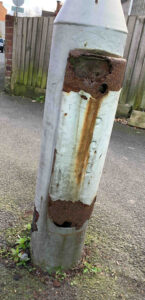
Lighting column with severely corroded access cover
External corrosion around the access opening appears minimal. However, the column is still unsafe because of risk of exposed electrical components.
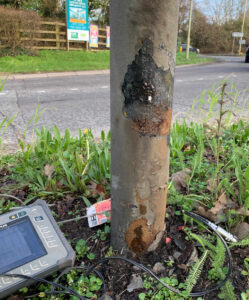
Ultrasonic thickness checking
The most critical area of corrosion is just above and just below ground level in the presence of both moisture, oxygen and electrolytes from soil and road salt.
A second critical area is the reverse side of the lighting column access opening. The column access opening is the structurally weakest area even in the absence of corrosion.
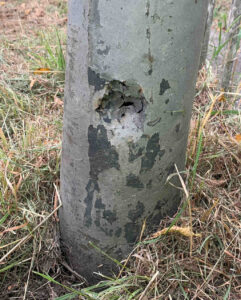
Lighting column internal corrosion
The paint looks to be good very conditions! When viewed from a distance, it appears that the lighting column has been hit by a blunt projectile. Maybe impact following a lapse of attention when cutting the grass?
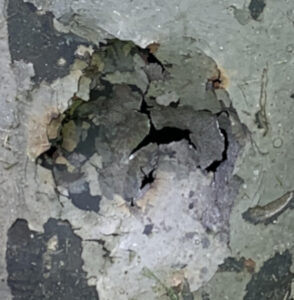
Lighting column internal corrosion
A closer inspection exonerates local vandals and careless grass cutter drivers. Severe internal corrosion has reduced the wall thickness to that of the paint.
Checking a lighting column wall thickness using Eddy Current Testing
Eddy current testing enable the column wall thickness to be checked below ground level. An magnetic field is induced in the column. A probe is then inserted. The interference between the probe and magnetic field enable the uncorroded (remaining) wall thickness to be assessed.
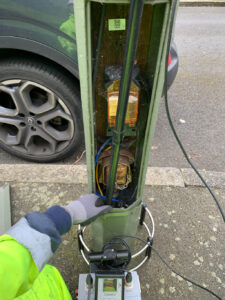
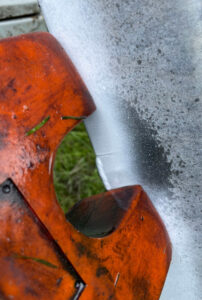
Magnetic Particle Testing (MPI) around lighting column welded attachment
Fatigue cracks starting from the ends of welds are a common failure point.
The test area is sprayed with a white paint to create contrast. Next the area is sprayed with a liquid containing metal particles. A hand held electromagnet induces an electrical field. The metal particles then align with the electric field.
Cracks within the structure disturb the electric field thus allowing identification.
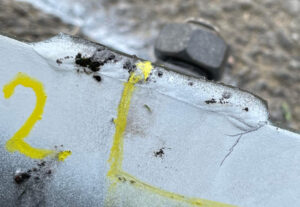
Magnetic Particle Testing (MPI) around lighting column welded attachment
A close-up of a crack initiated at the toe of a weld. (This crack is similar to that above but for a different weld).
The geometry of this weld creates a very stress concentration factor and high risk of fatigue cracking. i.e. The weld creates a notch. This weld is at a high risk because the stress concentration is located at a point of maximum bending stress in the main structure.
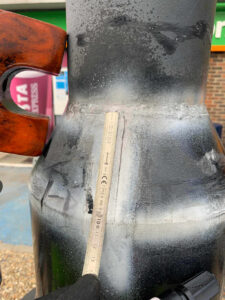
Magnetic Particle Testing (MPI) around lighting column size transition
Weld cracking can be caused by both loads imposed on the structure and the welding process. The relatively low stress in the longitudinal weld and uniformity of the “toe cracking” almost certainly points towards a fault in the welding process.
The test area is sprayed with a white paint to create contrast. Next the area is sprayed with a liquid containing metal particles. A hand held electromagnet induces an electrical field. The metal particles then align with the electric field.
Cracks within the structure disturb the electric field thus allowing identification.
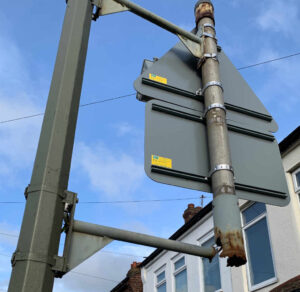
Corroded Road Sign supported from lighting column.
Attachments supported from lighting columns can be just as much of a risk to vehicles and pedestrians as the column.
Motorway road sign on embankment adjacent to hard shoulder.
Notice the difference in corrosion between nearest and furthest columns. The support column nearest the hard shoulder is within the “cloud” of salt laden spray generated by passing traffic.
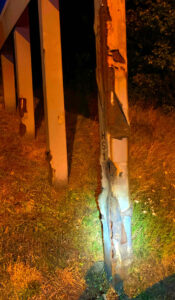
Anchor bolt for a standoff baseplate
This bolt was replaced because of excessive corrosion. However, the bolt was at also high risk of failure due to both over- stress and fatigue.
The absence of tensile pre-load below the nut significantly reduces the fatigue life of the bolt threads caused by repeated wind loads.
The distance between the concrete foundation and the nut would create high bending stresses in the bolt. Bending stresses in standoff base plate anchor bolts are normally ignored because the distance between the nut and concrete is “small”. i.e. No greater than the bolt diameter. However, in this case the distance between nut and concrete is at least 3 x bolt diameter. Bending stresses due to wind loading would not have been “insignificant”!
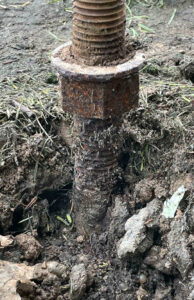
Anchor bolt with a stand-off baseplate
Anchor bolts with easy access for wrapping with “Denso Tape” and for visual inspection underneath the base plate does not always mean less corrosion! “Denso Tape” is difficult to perfectly fit to prevent corrosion. “Denso Tape” also has a short working life.
Easy access for inspection and wrapping also means easy access for oxygen, moisture and anti-icing salt.
Note! The distance between the concrete and lower levelling nut should be less than 1x bolt diameter to assume that bending stresses in the bolts are insignificant as assumed for the original design.
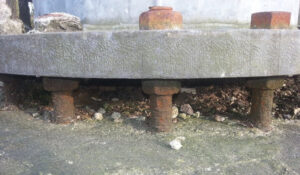
Ultrasonic inspection of an anchor bolt used with a stand-off baseplate
The purpose of ultra sonic inspection is to detect both corrosion and fatigue of the anchor bolt below the base plate.
Stand-off base plates are supported above the top of concrete on levelling nuts. However, in many cases the area below the levelling nut is not easily accessible for visual inspection.
Ultrasonic Inspection from the top of the bolt is the only available method to assess corrosion below the levelling nut.
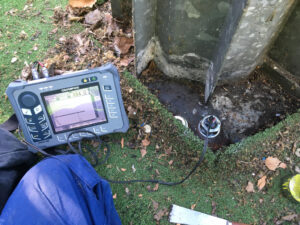
Why Choose Us
Quality always comes first at Caspian NDT. That means we pore over every minute detail throughout the entire inspection process.
We are flexible
We continuously strive to meet our client requirements and work independently or as part of a multi-disciplined team within your premises or on-site at construction, fabrication projects.
Professionals Only
Our technicians are extremely well qualified and experienced and meet our exacting standards of skill, professionalism and commitment. Because we often work within hazardous situations, we always follow stringent safety guidelines in accordance with the relevant legislative requirements.
What Our Customers say
Caspian Ndt have been providing us with exceptional non-destructive testing services. both at our base at Manchester and overseas.
We have found the Non-Destructive Testing services from Caspian ndt Ltd to be of the highest level. They have exceptional knowledge of NDT processes and issue comprehensive reports within 3 days of any works being completed.







